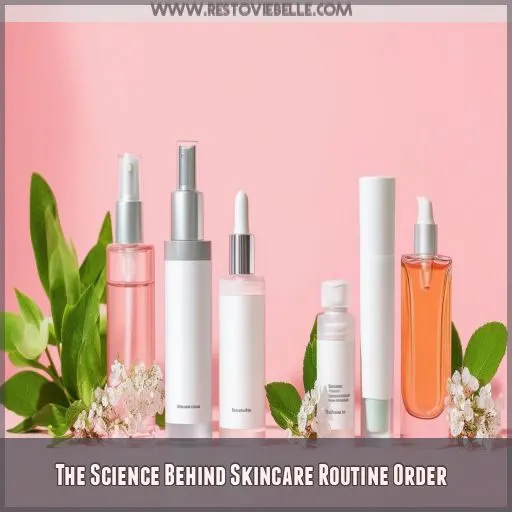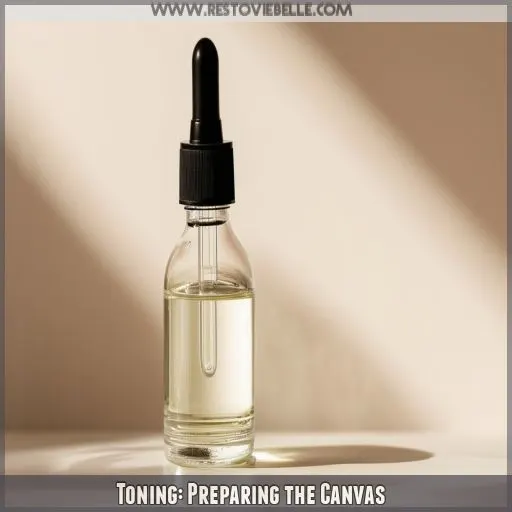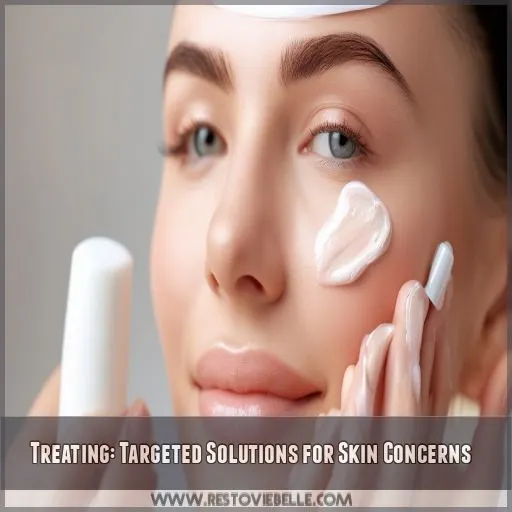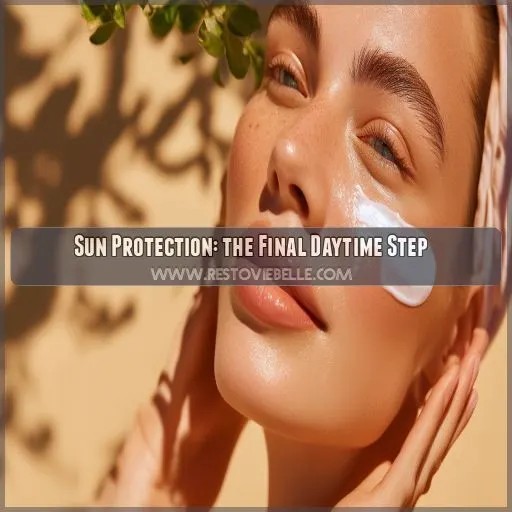This site is supported by our readers. We may earn a commission, at no cost to you, if you purchase through links.

We will walk you through five simple steps that bring new light into your regimen. From cleansing through sun protection, learn why the sequence in which products are applied makes all the difference for absorption, effectiveness, and ingredient interactions in this crucial skincare step.
Master your skincare, and open up the magic to healthy, radiant-looking skin.
Table Of Contents
- Key Takeaways
- Why Skincare Routine Order Matters?
- The Science Behind Skincare Routine Order
- Why Layering Matters in Skincare
- Morning Vs. Evening Routine Differences
- Cleansing: the Foundation of Any Routine
- Toning: Preparing the Canvas
- Treating: Targeted Solutions for Skin Concerns
- Moisturizing: Sealing in the Benefits
- Sun Protection: the Final Daytime Step
- Frequently Asked Questions (FAQs)
- Does the order of skincare really matter?
- What order should your skincare routine be in?
- Why is a skin care routine important?
- What are the 7 steps of skincare?
- How often should I change my skincare routine?
- Can I mix different skincare brands in my routine?
- Should I adjust my routine based on seasons?
- How long before seeing results from a new routine?
- Is it necessary to use every step every day?
- Conclusion
Key Takeaways
- Think of your skin as a picky eater – it wants its meals served in just the right order! Slapping on products willy-nilly is like trying to eat dessert before your veggies. Start with a clean plate (cleansing), prep the palate (toning), then dig into the main course (treating), before sealing the deal with a moisture-rich finale.
- Your AM and PM skincare routines are like Batman and Robin – dynamic duos with different missions. Morning? It’s all about shielding your skin from the villains of the day (hello, UV rays!). Night? Time for some superhero-level repair and regeneration while you catch those Z’s.
- Layering your skincare products isn’t rocket science, but it is science! Think thin to thick, like building the perfect sandwich. You wouldn’t slap the bread on top of the fillings, would you? Same goes for your face – let those lighter products sink in before piling on the heavy hitters.
- Sunscreen is the cherry on top of your morning skincare sundae. Skip it, and you might as well be inviting wrinkles over for a party. It’s your skin’s bouncer, keeping those troublemaking UV rays from crashing your complexion’s good time.
Why Skincare Routine Order Matters?
The skincare order does matter; it means maximizing the effectiveness of every single product one has applied. You can think about it like building a house: you need a strong foundation before you add walls and a roof. Beginning with thin, water-based products and building to thicker, oil-based products allows for proper absorption.
The morning routine is about protection; the evening routine is about repair. Cleanse to set the stage, tone to prepare your skin, and moisturize to lock in benefits.
This order also prevents interactions of ingredients that could inactivate or reduce effectiveness. Following the correct sequence means you’re not just slapping on products; instead, you’ll get an orchestra working in perfect harmony for your skincare.
Ready to unlock the secret of a perfectly ordered routine?
The Science Behind Skincare Routine Order
You ever wondered why the order in your skincare routine matters so much? The thing here is all about science—skin absorption and product efficacy**. Your skin structure plays a vital role in how products are penetrating and ultimately working. Thin, water-based products go first, followed by thicker, oil-based ones. By layering this way, you’ll optimize absorption so each product does its job to its best.
Active ingredients need a specific environment to work their wonders. Some of these ingredients are pH-sensitive or otherwise require special conditions to get moving. That’s why toners prime your skin, and serums go on before moisturizers are applied.
Daytime and nighttime rituals differ because your skin has different needs during this cycle. During the day, protection is paramount; at night, it’s all about repair and regeneration. These scientific principles enable one to target specific skin concerns better and get more out of skincare rituals.
Why Layering Matters in Skincare
Proper layering of skincare products is essential for maximum absorption and efficacy. In what order you apply your products can dramatically affect how well they work and interact with your skin to decide how effectively your routine in skincare works.
Absorption and Efficacy
Why layering of skincare products matters is all about absorption and efficacy. Products applied from thin to thick ensure maximum penetration. If you skip this order, you’re wasting your time and diluting the effects.
Toners prep your skin, serums deliver, and moisturizers lock it all in. This results in enhanced skin health and that radiant, head-turning glow.
Trust the science; after all, it’s your skin’s best friend.
Ingredient Interactions
But beyond absorption, how well your skincare works also depends on the interactions between ingredients. Some work synergistically, amplifying benefits, while others may clash.
For instance, vitamin C and niacinamide can supercharge anti-aging defense when paired together in your skin. Still, retinol and AHAs could irritate if applied simultaneously.
Knowing these interactions guarantees you work toward radiant skin by maximizing your routine’s potential.
Morning Vs. Evening Routine Differences
Your morning and evening skincare routines should be different since your skin has different needs in the morning and evening. In the morning, your products should protect and hydrate; at night, they repair and regenerate. Your skin type becomes an essential factor for individualizing these routines.
- AM: Cleanse, apply antioxidants, moisturize, and finish with sunscreen.
• PM: Double cleansing, actives, retinoids, locking in moisture
- Nighttime ingredients are often stronger and may cause sensitivity to sunlight
• Morning products should be light and easily absorbed under makeup.
- Evening routines can include heavier creams to work while you sleep
Cleansing: the Foundation of Any Routine
You’ve heard it a million times: Cleansing is the basis of good skincare. But why? It’s elementary: Cleansing rids the skin of grime from the day and extra oil and makeup, prepping your skin for the good stuff ahead. Think of it as a clean slate. Here’s how to do it right: Double cleanse. Begin with an oil-based cleanser to melt away makeup, followed by a gentle, skin-type-specific cleanser that gets deep into pores to clean them out.
Morning or night, cleansing sets the stage for your skincare symphony. In the morning, it’s connected with refreshing and removing the overnight buildup. Then comes PM, where you’re faced with the battle of the day against your skin. So look for cleansers that come packed with nourishing antioxidants that help lend some support to your skin. Note that harsh cleansers can be a no-go, especially for dry skin. Your face isn’t a dirty dish; treat it with care!
Toning: Preparing the Canvas
Now, after cleansing, your canvas needs some toning. It’s usually a skipped step that rebalances your skin’s pH level and readies it for whatever is to go on top.
You’ll find that there’s a toner appropriate for your skin category or specific needs. If you’re leaning towards oily skin, the ingredients would be salicylic acid, which would be helpful as an exfoliant. If dry, humectant ingredients such as glycerin increase the hydration levels. Don’t forget about the anti-aging benefits—some toners contain peptides that can help firm your skin up.
Rubbing it in with your hands instead of using a cotton pad ensures that you won’t waste product and absorb better. Light, gentle pats of the toner into your skin, and you’ll be shocked at not only how refreshing it instantly leaves one but also how well it preps the face for everything else.
Treating: Targeted Solutions for Skin Concerns
After cleansing and toning, it’s time to address your specific skin concerns with targeted treatments. Serums, packed with active ingredients, should be applied in order of thinnest to thickest consistency, allowing each layer to absorb fully before moving on to the next step.
Serums and Their Placement
Serums are your secret weapon in the fight for healthy skin. Apply them after cleansing and toning, but before moisturizing.
In the morning, opt for antioxidant-rich serums to shield against free radicals. Evening serums can focus on repairing and rejuvenating.
Active Ingredients and Timing
After layering serums, consider active ingredients and their timing. These powerhouse components can be specialized to various skin concerns; however, how you use them is everything. Here’s what you need to know:
Apply retinoids at night to fight sun damage.
Apply vitamin C in the morning for antioxidant protection.
Incorporate chemical exfoliants 2-3 times a week into oily, acne-prone skin.
• Layer hydrating ingredients before occlusive ones for maximum absorption.
Moisturizing: Sealing in the Benefits
You should moisturize at the end of your skincare routine to seal that hydration and allow other products applied previously to absorb much better. This important step also creates a barrier against environmental stressors for maintaining healthier skin throughout the day.
Lock In Skin Hydration
Locking in hydration is essential for your healthy skin. Your face moisturizer naturally acts as a barrier, stopping water loss and protecting against irritation. Here is how you can quickly master the components of a moisturizer:
| Ingredient Type | Function | Examples |
|---|---|---|
| Humectants | Attract water | Glycerin, Hyaluronic acid |
| Emollients | Soften skin | Shea butter, Jojoba oil |
| Occlusives | Seal moisture | Petrolatum, Dimethicone |
| SPF | Sun Protection | Zinc oxide, Titanium dioxide |
| Antioxidants | Free radical scavengers | Vitamin C, Green tea extract |
Enhance Product Absorption
Moisturizing doesn’t just hydrate; it boosts absorption of previous products. You’ll maximize efficacy and prevent dilution by sealing everything in. This step enhances skin health and helps:
- Boost absorption of active ingredients
- Prevent product waste
- Increase firmness
- Prepare skin for treatments like LED light therapy
Barrier Against Environmental Stressors
Your moisturizer doesn’t just hydrate; it’s your skin’s shield against environmental stressors. By locking in the benefits of your previous products, it creates a protective barrier that keeps pollutants out and moisture in, helping to prevent fine lines and maintain your glow.
Sun Protection: the Final Daytime Step
Now that you’ve sealed all those nourishing ingredients, it’s time for the grand finale of your morning routine: sun protection. You can think of sunscreen as your skin’s armor against the aging effects of UV rays. Slather on a broad-spectrum SPF last to make sure you’re guarded against such radiations, both UVA and UVB. Timing is everything here: Wait a few minutes after moisturizing to let it set in before applying sunscreen.
Prevention isn’t just against sunburn; it’s also your best defense for avoiding premature aging and skin damage. Keep in mind that UVA rays can pass through clouds and windows, so the application of SPF should become a daily habit—rain or shine.
This last step isn’t only for completing the routine; it’s also an investment in your skin’s long-term health and radiance.
Frequently Asked Questions (FAQs)
Does the order of skincare really matter?
Yes, it really does matter. You get your maximum value for products by applying them in the right order.
Always cleanse first, and then go from thinnest to thickest. In this way, all ingredients absorb fully into the skin without interference so maximum activity of active ingredients is achieved.
Never skip steps if you want to optimize your use of skincare products.
What order should your skincare routine be in?
Like building a house, your skincare routine should have a solid foundation. Cleanse first, then tone. Apply serums, followed by eye cream. Moisturize next, and finish with sunscreen. This order maximizes product absorption and effectiveness.
Why is a skin care routine important?
A skincare routine is very essential to maintaining excellent and glowing skin. It works by cleaning, nourishing, and protecting your skin while targeting issues, such as aging or acne. The advantage of adhering to a program is that you can avoid damage, promote cell renewal, and eventually get to see your beautiful natural skin.
What are the 7 steps of skincare?
Curious about the 7 steps of skincare? Here they are: cleanse, tone, exfoliate, treat (with serums), apply eye cream, moisturize, and protect with sunscreen. Follow this order to maximize product effectiveness and achieve healthier, glowing skin.
How often should I change my skincare routine?
Re-evaluate your skincare routine every 4-6 weeks. Notice how your skin responds, and adjust accordingly. Seasonal changes or aging processes may occur, or even lifestyle adjustments—tweaks that could be made to keep the skin at optimum health and appearance.
Can I mix different skincare brands in my routine?
Holy skincare, Batman! You can absolutely mix brands in your routine. It’s not about the label, but the ingredients and how they work together. Just introduce new products gradually and monitor your skin’s response.
Should I adjust my routine based on seasons?
Yes, you should adjust your skincare routine seasonally. Your skin’s needs change with temperature and humidity fluctuations. In winter, focus on hydration; in summer, prioritize sun protection. Adapt your products and routine to maintain healthy, balanced skin year-round.
How long before seeing results from a new routine?
You’ll typically see initial changes in 4-6 weeks, but significant results can take 3-4 months. Consistency’s key. Skin cell turnover cycles every 28 days, so give your new routine time to work its magic.
Is it necessary to use every step every day?
Imagine skipping sunscreen on a sunny beach day. Ouch! Similarly, not every skincare step is daily essential. You can tailor your routine, focusing on cleansing, moisturizing, and SPF. Adjust other steps based on your skin’s needs.
Conclusion
Who knew slapping on skincare products willy-nilly wasn’t the secret to glowing skin? Now you understand why skincare routine order matters. By following these five steps, you’ll maximize product effectiveness and boost your skin’s radiance.
Whether it’s your morning or evening routine, stick to this sequence: cleanse, tone, treat, moisturize, and protect.
Your skin will thank you with a healthier, more luminous appearance. Embrace the power of order in your skincare journey.














